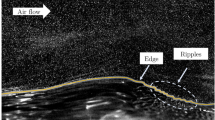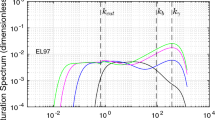Abstract
Airplane aerodynamic characteristics correlate aircraft speed with vertical wind velocity, making the time average inappropriate for estimating the ensemble average in airborne eddy-correlation flux computations. The space average, the proper form, is implemented as a time integral by a transformation of variables, which can be interpreted as a ground-speed correction to the time average. The mathematical forms are presented, and the importance of the speed correction is illustrated with airborne data. The computed correction is found to be highly variable, depending on both the turbulent flow encountered and the aircraft used. In general, the speed connection becomes more important as airplane size is reduced. For a small, single-engine Long-EZ airplane, used as an example, the straight time average erred, half the time, by 12%, 10%, 20%, and 15%, respectively, for computed fluxes of momentum, heat, moisture, and CO2. For a much heavier Twin Otter airplane, also used as an example, the straight time average erred, half the time by only 1%. These errors increased with decreasing altitude for the Long-EZ and with increasing altitude for the Twin Otter.
Similar content being viewed by others
References
Crawford, T. L., Dobosy, R. J., and Birdwell, K. R.: 1993, ‘Airborne Measurements of Mass, Momentum and Energy Flux for ARM’,NOAA Technical Memorandum ERL ARL-202, 150 pp.
Crawford, T. L. and Dobosy, R. J.: 1992, ‘A Sensitive Fast-Response Probe to Measure Turbulence and Heat Flux from Any Airplane’,Boundary-Layer Meteorol. 59, 257–278.
Doran, J. C., Barnes, F. J., Coulter, R. L., Crawford, T. L., Baldocchi, D. D., Balick, L., Cook, D. R., Cooper, D., Dobosy, R. J., Dugas, W. A., Fritschen, L., Hart, R. L., Hipps, L., Hubbe, J. M., Gao, W., Hicks, R., Kirham, R. R., Kunkel, K. E., Martin, T. J., Meyers, T. P., Porch, W., Shannon, J. D., Shaw, W. J., Swiatek, E., and Whiteman, C. D.: 1992, ‘The Boardman Regional Flux Experiment’,Bull. Am. Meteorol. Soc. 73, 1785–1795.
MacPherson, J. I.: 1990, ‘NAE Twin Otter Operations in FIFE,National Research Council Canada Report, LTR-FR-113. June 1990. (Available from NRCC, Ottawa, Ontario, K1A 0R6.)
Seckel, E.: 1961,Stability and Control of Airplanes and Helicopters, Academic Press, New York, 485 pp.
Taylor, G. I.: 1938, ‘The Spectrum of Turbulence’,Proc. R. Soc. London, Ser. A 164, 467–490.
Webb, E. K., Pearman, G. I., and Leuning, R.: 1980, ‘Correction of Flux Measurements for Density Effects Due to Heat and Water Vapor Transfer’,Q. J. R. Meteorol. Soc. 106, 85–100.
Author information
Authors and Affiliations
Additional information
Oak Ridge Associated Universities, assigned to NOAA/ATDD.
Rights and permissions
About this article
Cite this article
Crawford, T.L., McMillen, R.T., Dobosy, R.J. et al. Correcting airborne flux measurements for aircraft speed variation. Boundary-Layer Meteorol 66, 237–245 (1993). https://doi.org/10.1007/BF00705476
Received:
Issue Date:
DOI: https://doi.org/10.1007/BF00705476




